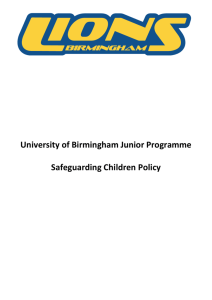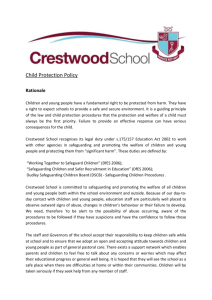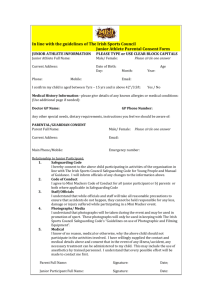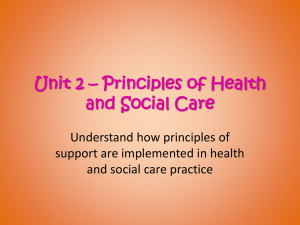Child Protection Policy Oct 2012
advertisement
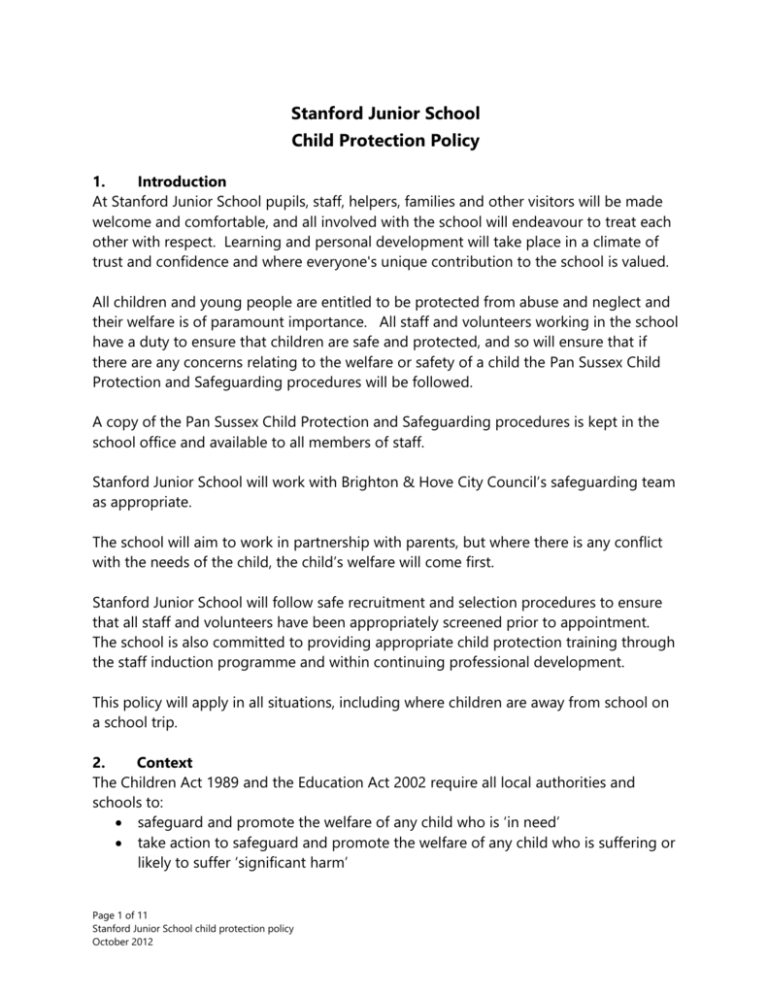
Stanford Junior School Child Protection Policy 1. Introduction At Stanford Junior School pupils, staff, helpers, families and other visitors will be made welcome and comfortable, and all involved with the school will endeavour to treat each other with respect. Learning and personal development will take place in a climate of trust and confidence and where everyone's unique contribution to the school is valued. All children and young people are entitled to be protected from abuse and neglect and their welfare is of paramount importance. All staff and volunteers working in the school have a duty to ensure that children are safe and protected, and so will ensure that if there are any concerns relating to the welfare or safety of a child the Pan Sussex Child Protection and Safeguarding procedures will be followed. A copy of the Pan Sussex Child Protection and Safeguarding procedures is kept in the school office and available to all members of staff. Stanford Junior School will work with Brighton & Hove City Council’s safeguarding team as appropriate. The school will aim to work in partnership with parents, but where there is any conflict with the needs of the child, the child’s welfare will come first. Stanford Junior School will follow safe recruitment and selection procedures to ensure that all staff and volunteers have been appropriately screened prior to appointment. The school is also committed to providing appropriate child protection training through the staff induction programme and within continuing professional development. This policy will apply in all situations, including where children are away from school on a school trip. 2. Context The Children Act 1989 and the Education Act 2002 require all local authorities and schools to: safeguard and promote the welfare of any child who is ‘in need’ take action to safeguard and promote the welfare of any child who is suffering or likely to suffer ‘significant harm’ Page 1 of 11 Stanford Junior School child protection policy October 2012 Definitions of these terms are in Appendix One of this policy. Safeguarding children includes a duty to protect children from maltreatment and duty to prevent impairment. Promoting children’s welfare means creating opportunities to enable children to have optimum life chances. Through day-to-day contact with children and direct work with parents, staff have a crucial role to play in noticing indicators of possible abuse or neglect and referring those concerns to the appropriate investigative agencies (social services and police). 3. Categories of abuse Abuse can be categorised as physical abuse, sexual abuse, emotional abuse or neglect. The most common form of child abuse is neglect. Physical abuse includes non-accidental injuries such as bruising, wounding, burns and fractures. Sexual abuse is the involvement of children or young people in sexual activity, including the abuse of a position of trust by an adult with professional responsibility for a child. Emotional abuse is the persistent emotional ill treatment such as the extreme denial of love, affection or approval. Neglect is the chronic inattention to basic needs. Indicators of abuse in these categories are in Appendix One of this policy. Staff at Stanford Junior School will be trained to recognise and respond to the categories and indicators of potential abuse. 4. Designated person At Stanford Junior School the designated person with responsibility for child protection is the school’s inclusion coordinator, currently Sinead Kiernan. The designated person of staff for child protection will have regular child protection training and will make sure that all staff and volunteers know how to recognise and report any concerns or indications that a child is or has been abused or neglected. Page 2 of 11 Stanford Junior School child protection policy October 2012 The designated person will provide information to the school’s governing body regarding the number, nature and outcomes of referrals made. The designated person will make any necessary contact with the appropriate safeguarding team or the police and will make sure that the school follows the Pan Sussex Child Protection and Safeguarding procedures, and contributes fully to the child protection process. The designated person will also be responsible for ensuring the central record of child protection training is kept up to date. In the absence of the designated person the head teacher, currently Gina Hutchins (interim), will act as designated person (hereinafter referred to as deputy designated person). 5. Action to be taken regarding child protection concerns All child protection concerns should be logged in a file which will be kept in a locked cabinet, located in the Headteacher’s office. All referrals must be made to the designated person, who will provide support and guidance and if appropriate will make a referral to the safeguarding team and if necessary the police. Sometimes concerns that a child is suffering or is likely to be suffering some form of abuse will build up slowly over time, and some will be as a response to a child presenting an injury or mark or talking about a worrying issue. It is therefore important to record any concern regarding a child, even if no further action is taken in the first instance. 6. Disclosures If a child discloses abuse in school, the person hearing the disclosure should: listen and allow the child to recall freely; reassure the child that they are believed; make notes as soon as possible recording as accurately as possible the words used by the child; be clear with the child that the information will have to be passed on and that there are people who will be able to help re-assure the child that they are doing the right thing by disclosing this information. refer to the designated person who will contact the safeguarding team and the police if necessary. Page 3 of 11 Stanford Junior School child protection policy October 2012 The adult should not ask the child questions as this is the role of social workers and police officers. Others posing questions to the child could contaminate potential evidence of a crime. 7. Information sharing Stanford Junior School will share information with parents and partner agencies in order to: support early intervention to help children and parents who need additional services to achieve positive outcomes, and ensure the duty to safeguard children and promote their welfare is fulfilled. The Data Protection Act (1998) is not a barrier to sharing information, but is in place to ensure that personal information is shared appropriately. In order to share information professionally and lawfully, information will be shared in accordance with the following guiding principles1 7.1 Parents will be told openly and honestly at the outset what information will or could be shared, and why, and will seek their agreement, except where doing so puts the child or others at risk of significant harm. 7.2 The child's safety and welfare must be the overriding consideration when making decisions on information sharing. 7.3 Information which is shared will be accurate, up-to-date, necessary for the purpose for which it is being shared, and shared securely and only with those who need it. 7.4 The wishes of children and parents will be respected where they do not consent to share confidential information, unless there is sufficient need to override that lack of consent. 7.5 Advice will be sought when in doubt. 7.6 Decisions to share or not to share information will be recorded. This must include the decision itself, including any direction given by the designated Making It Happen: working together for children, young people and families (DfES,2006), which sets out six key points and guiding principles on information sharing 1 Page 4 of 11 Stanford Junior School child protection policy October 2012 person, the information which is shared and the identity of practitioners with whom it is shared, where appropriate. The decision to share information when there are child protection concerns will be made by the designated person. 8. Record keeping The Data Protection Act (1998) states that personal information held by agencies must be obtained and processed fairly and lawfully and stored securely. It must be accurate, proportionate to the purpose, not held longer than necessary and may only be disclosed in appropriate circumstances. Where concerns arise about the safety or wellbeing of a pupil, or there are indications that the child may be suffering or at risk of suffering significant harm, staff will record: the reason for the concern; what was said or witnessed and details of any other persons present; dates and times of incidents and when the notes were made; date, time and outcome of any discussion with the parent; and date, time and outcome of any discussion with the head teacher, social work services staff or other relevant professionals consulted. Staff will use the school’s welfare concern forms and will distinguish between fact, opinion and hearsay. Notes will be passed to the designated person who will keep all welfare concerns and child protection records in a locked cabinet as outlined in Section 5 above. These records form evidence and may be used in the child protection referral and any subsequent investigation or legal proceedings. They are exempt from the open file regulations and do not have to be made available to parents requesting access to their child’s file. However, unless to do so would put a child at significant risk, parents may see these records, since good practice and partnership working dictates that if anything is significant enough to be recorded it should be discussed with parents, unless this increases risks for the child or damages the potential for evidence collection. Any welfare and child protection records will be passed on to the child’s next school if the designated person believes they still constitute a concern. If the designated person’s judgment is that the records do not constitute a concern they should be shredded when the child leaves Stanford Junior School. Page 5 of 11 Stanford Junior School child protection policy October 2012 Any formal records of child protection groups or meetings will be held by the Council’s safeguarding team which will assume responsibility for the appropriate storage of these records. 9. Training All members of staff, including the head teacher, will receive child protection training as part of their induction. This will be updated every three years by the designated person for child protection. Staff will attend other safeguarding training as appropriate. All volunteers and short-term or supply staff will be informed of their responsibility to safeguard children as well as the name of the designated person. The school’s governing body has a lead member for child protection, currently Juliet McCafferty. The lead member will undertake training, and monitor child protection training and training records with the designated person and head teacher. The designated person will attend roles and responsibilities training and Local Safeguarding Children Board (LSCB) inter-agency training at a minimum every two years. The deputy designated person will also undertake the training. The head teacher will attend roles and responsibilities training every three years and other safeguarding training as appropriate. 10. Confidentiality Confidential information about children, families or others within the school should be kept secure and privacy respected. Where there are concerns that a child is suffering or likely to suffer significant harm, information must be shared with the designated person in the first instance and may subsequently be shared with the Council’s safeguarding team and the police. This information will be shared in accordance with Paragraph 7 of this policy. Where staff or other adults in the school have concerns, either because of what they have seen or heard or in relation to a direct disclosure by a child, they cannot keep this information confidential and the child must not be told that this is possible. This information must be shared with the designated person in the interests of safeguarding the child. The child must be informed that this will happen. Other staff may need to be alerted to concerns about a child, possibly in order to monitor the concern or to gather further evidence prior to a referral being made, or to Page 6 of 11 Stanford Junior School child protection policy October 2012 assist in providing appropriate support to a child after a referral has been made. Information will be shared in accordance with Paragraph 7 of this policy. 11. Allegations against staff All members of staff and volunteers at Stanford Junior School are entitled to receive care and protection from harm. Inappropriate behaviour towards pupils or staff is not acceptable and any concerns or allegations of impropriety will be dealt with quickly, fairly and sensitively. In the event of an allegation of abuse against a member of staff or other adult in school, the head teacher will seek advice from the local authority designated officer (LADO) and will agree the procedure to be followed. If an allegation is made against the head teacher the chair of governors will seek advice from the LADO and agree the procedure to be followed. Any staff disclosing information regarding inappropriate behaviour by a colleague will be listened to and supported. Parents of a child allegedly abused by a member of staff or other adult in the school will be kept informed of the progress and outcome of any investigation. Any member of staff facing investigation into an allegation of abuse will be subject to the procedures laid down by the joint Department for Education and Skills/National Employers Organisation for School Teachers guidance and will be offered appropriate access to professional and personal support networks. They will also be kept informed of the progress and outcome of any investigation. 12. Working with outside agencies Stanford Junior School recognises the authority of the LSCB and is committed to working in partnership with the Council and the police. The school will comply with the Pan Sussex Child Protection and Safeguarding procedures and will be proactive in working together to safeguard children. Information will be shared through the designated person with investigating teams, and staff will contribute to child protection conferences, core groups and care plans. Any incident requiring advice from or referral to, safeguarding teams and arising out of normal hours will be referred directly to the emergency/out of hours team or failing that directly to the police child protection team. 13. Recruitment Page 7 of 11 Stanford Junior School child protection policy October 2012 The senior management team will ensure that recruitment and selection policy and practice is thorough in following up references, Criminal Records Bureau checks and investigating career gaps, and fulfills the requirements of the Independent Safeguarding Authority (ISA). At least one member of each recruitment panel will have undertaken appropriate training to ensure that interviews to appoint staff reflect the importance of safeguarding children. All staff, including supply staff, on-site contractors, support services and volunteers working in the school will be given induction information regarding this policy and will fulfill ISA requirements. 14. Particularly vulnerable children Stanford Junior School recognises that disabled children and those with special needs may be more vulnerable to abuse, and may be less able to tell people about abuse happening to them. Therefore rigorous child protection procedures are in place, especially with regard to recruitment, checks on volunteers and paid workers, whistleblowing policies, as well as guidelines setting out acceptable behaviour by those working with disabled children. Support for children for whom English is an additional language and children in care may also require extra consideration. 15. Capital works on the school site Stanford Junior School will ensure that during the progress of any building or other on site works, contractors will be issued with relevant child protection information. This will include expectation of their conduct whilst on site. 16. Images of children At Stanford Junior School images of children are an important part of recording school life and achievements. A policy and procedure for the use of images of children is in place and is reviewed regularly in accordance with guidance on safeguarding children. 17. Links with other policies Stanford Junior School will develop and evaluate all school policies with a view to safeguarding and promoting the welfare of all its pupils, and will ensure that the child protection process is applied in all areas of practice. In doing so account will be taken of the principles outlined in this policy, ensuring that all other policies and procedures support the protection of children from harm or neglect, in particular through: recruitment and selection policy, to ensure that suitable staff are appointed; anti-bullying policy, to ensure physical and emotional security for all children and staff; special educational needs policy, to ensure that particularly vulnerable children are offered additional protection; Page 8 of 11 Stanford Junior School child protection policy October 2012 whistle-blowing policy, to ensure that individuals are confident about raising concerns; attendance and welfare policies, to ensure that absence is followed up quickly and vulnerable children are supported appropriately, as well as being empowered to learn and thrive, and behaviour policy, to ensure that appropriate rules and boundaries are in place and to be clear about the sanctions which apply. Page 9 of 11 Stanford Junior School child protection policy October 2012 Appendix One 1. Definitions In need In need means the child is unlikely to achieve or maintain, or to have the opportunity of achieving or maintaining, a reasonable standard of health or development without the provision of services by a local authority, or the child’s health or development is likely to be significantly impaired, or further impaired, without the provision of such services, or the child is disabled. Significant harm Significant harm means ill treatment or the impairment of health or development; Development means physical, intellectual, emotional, social or behavioural development; Health means physical or mental health; and ill treatment includes sexual abuse and forms of ill treatment which are not physical. If a child is suffering significant harm compulsory intervention by social work services may take place. 2. Indicators of abuse Physical abuse • obvious signs of injury; • injuries which are unusual or unexplained; and • injuries, which while explained are frequent. Sexual abuse • physical difficulties such as wetting or soiling; • extreme variations in behaviour; • sexualised language, behaviour of play; and • indirect disclosure through play, drawing or written work. Emotional abuse • low self esteem, unhappiness, fear, distress or anxiety; • attention seeking behaviours; and • emotional developmental delay. Neglect • dirty, unkempt appearance; • developmental delay; • low self esteem; and Page 10 of 11 Stanford Junior School child protection policy October 2012 • hunger. More details regarding indicators of abuse and risk factors are outlined in the Pan Sussex Child Protection and Safeguarding procedures. Page 11 of 11 Stanford Junior School child protection policy October 2012
